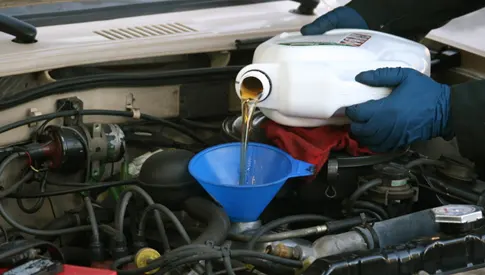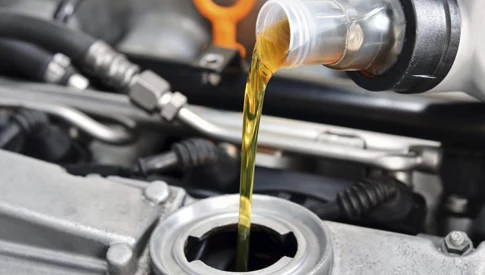Physical Address
304 North Cardinal St.
Dorchester Center, MA 02124
Physical Address
304 North Cardinal St.
Dorchester Center, MA 02124

Condensation occurs in engine oil when water vapor in the air cools and changes into a liquid. In the end, the vehicle becomes an oily mess. Fortunately, there are techniques for getting rid of condensation in engine oil.
You can use a vacuum pump to remove the water droplets from the oil. This method is effective, but it can be time-consuming and requires some skill. You can use additive dryers to absorb moisture. This method is effective when the condensation is excessive. Also, there are several methods you can use.
This article will discuss how to get rid of condensation in engine oil. We’ll also share tips on how to prevent it from happening again.

There are several ways to get rid of moisture in engine oil. The most common techniques are listed below:
A vacuum pump is a useful tool to remove water droplets from the engine oil. However, using a vacuum pump requires patience and some skill. You must know how much vacuum you must apply and how long to keep it running.
Also, you need to make sure that there are no air leaks, as vacuuming air will not remove the water droplets. Using a vacuum pump is an effective way of eliminating moisture in engine oil without trouble, but you need to have some experience under your belt.
Heating the engine is another effective way to evaporate water droplets from engine oil. But, you need to be cautious while doing this as excessive heat can damage the engine. You can use a heat gun or a hairdryer on a low setting to warm the engine.
It is advisable to start from the bottom and work your way up gradually. You should avoid using open flames or hot surfaces as this can create a fire hazard. Heating the engine is a quick and easy way to get rid of vapors in engine oil quickly and easily.
Silica gel or other drying agents can be added to the engine oil to absorb moisture. This method is effective, but it may not be necessary if the condensation is not excessive. You must ensure you use the right amount of drying agent, as excess drying agents can cause oil breakdown and engine damage.
Also, you need to replace the drying agents periodically. Adding dryers to the engine oil is a good way to prevent condensation, but it should be done cautiously.
If you notice excessive condensation in your engine oil, the best action is to change the oil completely. This will help remove the water droplets and prevent them from returning. Changing the oil is a simple process that requires minimal effort and only a few basic tools.
Using a dehumidifier is an efficient way to remove moisture from the air and prevent condensation from occurring in the future. A dehumidifier works by drawing in the air, removing the moisture, and then releasing the dry air into the room.

The smooth running of an engine is highly dependent on the oil in the system, and the presence of condensation in engine oil can lead to significant problems. Here are some reasons why your engine oil can condense:
Condensation can form when the temperature surrounding an oil cooler drops below the oil’s temperature. In these instances, vapor will condense and form droplets, leading to a reduction in the oil’s efficiency.
Also, when an engine is turned off, the oil cools faster than the air around it, leading to further condensation. Ensuring the oil cooler is operating correctly and keeping the oil at a consistent temperature can help prevent this issue.
Leakage is one of the primary causes of condensation in engine oil. A leak in the oil cap can allow cold air to enter the system, causing condensation to form and eventually damage the engine. Cracks in the oil cooler can also lead to leakage, making it vital to check for any signs of damage or wear regularly.
Humidity can also cause condensation in engine oil, as water vapor will turn into liquid droplets when it comes into contact with a cold engine.
Unfortunately, humidity is often out of our control, but regularly changing the engine oil and ensuring the oil filter is clean can help reduce the impact of humidity on the engine.
As engine oil ages, it loses its ability to resist condensation, making it more susceptible to the effects of temperature changes and humidity. Keeping track of the oil’s age and replacing it when necessary is essential to avoid condensation build-up.
Specific operating conditions, such as frequent stop-and-go traffic, can increase the engine oil temperature, leading to condensation formation.
Other factors, such as short trips and driving in cold climates, can also impact the oil’s performance. Regular maintenance and oil changes can help counteract these effects and ensure the engine runs smoothly.

There are several tips you can follow to prevent condensation from happening again in engine oil:
To prevent the accumulation of water droplets in your engine, keep it at a consistent temperature. This means avoiding sudden temperature changes by warming up your engine slowly and avoiding excessive idling.
Also, ensure your thermostat is functioning properly, and consider using a block heater in colder weather. Keeping your engine cool can also extend the life of your oil, preventing the need for frequent changes and saving you money in the long run.
The type of oil you choose can also affect the formation of condensation in your engine. Synthetic oils, in particular, are less likely to form water droplets thanks to their higher flashpoint. This means they can better withstand high temperatures without breaking down or forming sludge.
When choosing an oil, look for one with a high viscosity rating, which can help it stick to your engine’s components and prevent moisture from building up.
Another way to keep your engine at a consistent temperature is by using an oil cooler. This accessory can help regulate the temperature of your oil, preventing it from getting too hot or too cold.
By keeping your oil at the right temperature, you can minimize the chances of condensation forming. Oil coolers are relatively easy to install and can be a great way to extend the life of your engine.
A desiccant can be a useful tool for preventing moisture buildup in your engine compartment. These materials absorb water from the air, helping to keep your engine dry and prevent the formation of condensation.
Silica gel is a popular desiccant material that can be easily purchased at most auto parts stores. Simply place it in a breathable container in your engine compartment and let it do its job.

Storing engine oil in a cool, dry place prevents condensation. The cool temperature helps to reduce the moisture content in the air, which can lead to the formation of water droplets in the oil.
Also, keeping oil away from sunlight helps it stay usable for longer by preventing the breakdown of its chemical composition.
Checking the engine oil regularly is essential for identifying any changes in the oil’s color and texture.
If you notice that the oil is dirty or contaminated, change it immediately. The presence of impurities in the oil can cause the formation of water droplets, which can cause significant damage to your engine in the long run.
Using a filter is an effective way to remove impurities from the engine oil and prevent the water from forming.
The filter can help keep the oil clean and free from contaminants, ensuring that it remains in optimal condition for a more extended period. Investing in a quality filter is a must, especially if you want to increase your engine’s longevity.
Additives are an excellent way to prevent condensation from occurring in engine oil. The right type of additive can help to stabilize the oil, prevent the formation of water droplets, and improve the oil’s overall performance. Choose the right additive for your engine type to ensure it runs better for a longer time.
An effective way to get water out of an engine’s oil is to use a water dispersant additive such as Alcohol-Based Dispersant. These additives are alcohol-based components that naturally absorb water, making them an excellent solution for eliminating water from your engine oil reservoir.
These additives break down the surface tension of the water, allowing it to mix with the oil and be removed through the engine’s normal filtration process.
One effective way to remove water from your engine oil is to change it three to four times with inexpensive engine oil. Once you’ve completed this process, fill it with high-quality oil that doesn’t contain an emulsifier and run it for a short period.
This will cause the water and oil mixture to separate, with the water lying at the bottom.
Drain this water before changing engine oil again and add your normal oil to get your engine hot enough to evaporate any remaining water from the oil. It’s essential to follow the manufacturer’s instructions on the type and quantity of oil recommended for your vehicle.
If you find solid proof of water in your car’s engine oil, you must stop driving immediately. Operating your vehicle under these conditions can cause severe damage to your engine and worsen the problem.
Take your car to a trusted mechanic as soon as possible. They’ll need to inspect every engine part carefully to identify the cause of the contamination.
Driving your vehicle with water in the engine oil can cause critical issues such as corrosion, mildew, and other potentially dangerous problems. Avoid costly repairs and compromise your safety by addressing any engine issues promptly.
Condensation in engine oil can cause serious damage to your engine if it is not addressed properly. Whether you are a seasoned mechanic or a new car owner, understanding how to eliminate condensation in engine oil is essential.
However, using vacuum pumps, heating the engine, or using a dehumidifier are all effective ways to remove moisture and prevent further damage.
Identify the cause of condensation in your engine oil and take the necessary steps to prevent it from happening in the future. By using the right tools and techniques, you can ensure that your engine runs smoothly and efficiently for years to come.
We hope that the information presented in this article has been helpful to you and that you can put it into practice to keep your engine running smoothly.